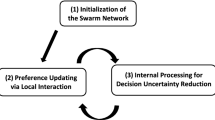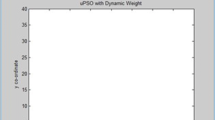Abstract
This paper proposes to use evolutionary computations to determine the parameters of probabilistic finite state machine controllers for swarm robots. The robots are evolved to perform an aggregation task. This problem was formulated as an optimization problem and solved by the PSO. Several computer simulations were conducted to investigate the validity of the proposed method. The results obtained in this paper show us that the proposed method is useful for the aggregation problem and the best evolved controllers are feasible as well as interpretable. This would be transferable to real swarm robots problems.













Similar content being viewed by others
Explore related subjects
Discover the latest articles, news and stories from top researchers in related subjects.Notes
Şahin [3] claimed that these criteria should be used as a measure of the degree of SR in a particular study.
\(N_o\) denotes the number of robots when the PSO was applied to design the PFSM.
References
Trianni V (2008) Evolutionary swarm robotics. Springer-Verlag, Berlin
Brambilla M, Ferrante E, Birattari M, Dorigo M (2013) Swarm robotics: a review from the swarm engineering perspective. Swarm Intell 7(1):1–41
Şahin E (2005) Swarm robotics: from sources of inspiration to domains of application. In: Şahin E, Spears WM (eds.) Swarm Robotics, Springer, New York, pp 10–20 (Lecture Notes in Computer Science 3342)
Sutton RS, Barto AG (1998) Reinforcement learning: an introduction. MIT Press, Cambridge
Nolfi S, Floreano D (2000) Evolutionary robotics: the biology, intelligence, and technology of self-organizing machines. MIT Press, Cambridge
Brooks RA (1992) Artificial life and real robots. In: Varela FJ, Bourgine P (eds) Toward a Practice of Autonomous Systems, Proceedings of the First European Conference on Artificial Life, MIT Press, Cambridge, pp 3–10
Jakobi N (1997) Half-baked ad-hoc and noisy: minimal simulation for evolutionary robotics. In: Husbands P, Harvey I (eds) Proceedings of the fourth european conference on artificial life, MIT Press, Cambridge, pp 348–357
Miglino O, Lund HH, Nolfi S (1995) Evolving mobile robots in simulated and real environments. Artif Life 2:417–434
Keymeulen D, Iwata M, Konaka K, Suzuki R, Kuniyoshi Y, Higuchi T (1998) Off-line model-free and on-line model-based evolution for tracking navigation using evolvable hardware. In: Husbands P, Meyer JA (eds) Evolutionary Robotics, First European Workshop EvoRobot 98, Springer, New York, pp 211–226 (Lecture Notes in Computer Science 1468)
Katada Y, Ohkura K (2006) An update method of computer simulation for evolutionary robotics. In: Arai T, et al (eds) Intelligent autonomous systems 9 IOS Press, Amsterdam, pp 357–364
Garnier S, Jost C, Jeanson R, Gautrais J, Asadpour M, Caprari G, Theraulaz G (2005) Aggregation behaviour as a source of collective decision in a group of cockroach-like-robots. In: Capcarrere MS, Freitas AA, Bentley PJ, Johnson CG, Timmis J (eds) Advances in artificial life, Springer, New York, pp 169–178 (Lecture notes in Computer Science 3630)
Soysal O, Bahçeci E, Şahin E (2007) Aggregation in swarm robotic systems: evolution and probabilistic control. Turk J Electr Eng Comput Sci 15(2):199–225
Gauci M, Chen J, Li W, Dodd TJ, Groß R (2014) Self-organised aggregation without computation. Int J Robot Res 33(9):1145–1161
Kennedy J, Eberhart RC (1995) Particle swarm optimization. In: Proceedings of IEEE international conference on neural networks, vol 4, Perth, 27 November–1 December 1995, pp 1942–1948
Brooks R (1986) A robust layered control system for a mobile robot. IEEE J Robot Autom 2(1):14–23
Pfeifer R, Scheier C (1999) Understanding intelligence. MIT Press, Cambridge
Graham RL, Sloane NJA (1990) Penny-packing and two-dimensional codes. Discrete Comput Geom 5(1):1–11
Katada Y, Nishiguchi A, Moriwaki K, Watakabe R (2016) Swarm robotic network using Lévy flight in target detection problem. Artif Life Robot 21(3):295–301
Open Dynamics Engine (ODE). http://ode.org/
Nouyan S, Campo A, Dorigo M (2008) Path formation in a robot swarm—self-organized strategies to find your way home. Swarm Intell 2(1):1–23
Liu W, Winfield A, Sa J (2009) A macroscopic probabilistic model of adaptive foraging in swarm robotics systems. In: Proceedings of 6th vienna international conference on mathematical modelling, Special session on modelling the swarm
Labella TH, Dorigo M, Deneubourg JL (2006) Division of Labor in a group of robots inspired by ants’ foraging behavior. ACM Trans Auton Adapt Syst 1(1):4–25
Author information
Authors and Affiliations
Corresponding author
Additional information
SWARM This work was presented in part at the 2nd International Symposium on Swarm Behavior and Bio-Inspired Robotics, Kyoto, October 29–November 1, 2017.
About this article
Cite this article
Katada, Y. Evolutionary design method of probabilistic finite state machine for swarm robots aggregation. Artif Life Robotics 23, 600–608 (2018). https://doi.org/10.1007/s10015-018-0496-0
Received:
Accepted:
Published:
Issue Date:
DOI: https://doi.org/10.1007/s10015-018-0496-0




